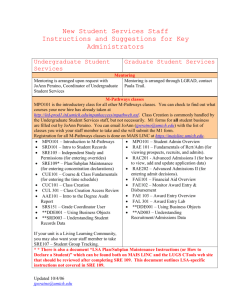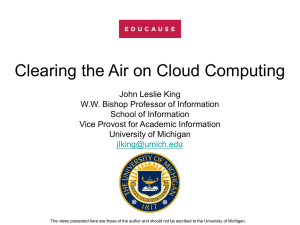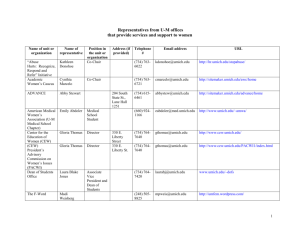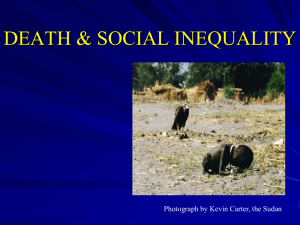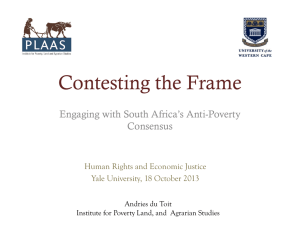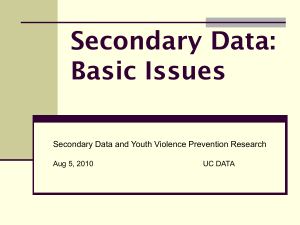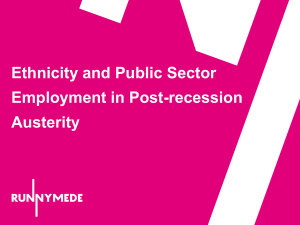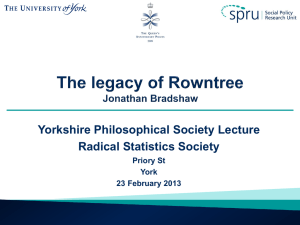View Powerpoint presentation - Office of the President
advertisement
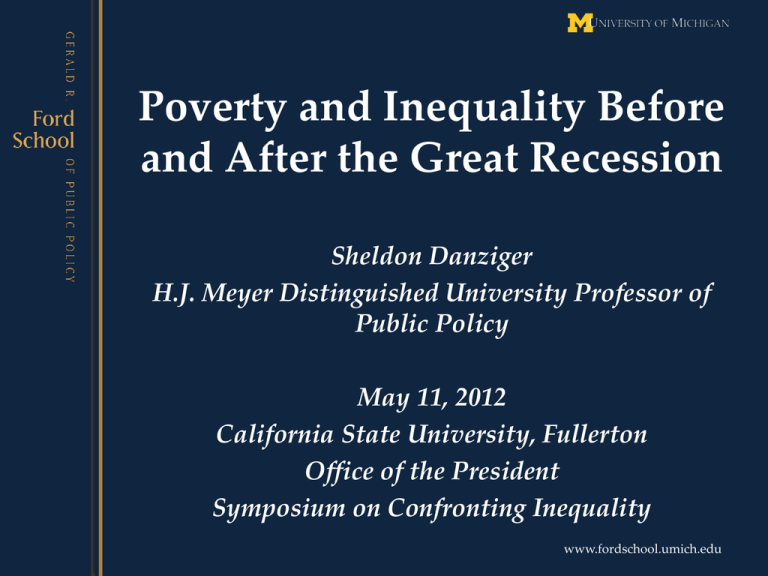
Poverty and Inequality Before and After the Great Recession Sheldon Danziger H.J. Meyer Distinguished University Professor of Public Policy May 11, 2012 California State University, Fullerton Office of the President Symposium on Confronting Inequality www.fordschool.umich.edu Overview Historical Trends in Poverty and Income Inequality—from a “Rising Tide Lifts all Boats,” to a “Gilded Age of Rising Inequalities” Lessons from the Great Recession and the 2009 Stimulus Act Implications for Reducing Poverty and Inequality in the Next Decade www.fordschool.umich.edu Following the 1973 Oil Crisis Poverty Rises during Severe Recession of Early 1980s Poverty Falls during Recovery, but not to 1973 level because lesseducated workers no longer benefit from economic growth Inequality Increases Rapidly Effective Safety Net Only for Elderly www.fordschool.umich.edu Causes of Rising Inequality Skill-biased technological change Globalization Decline in unionization Erosion of the minimum wage Declining progressivity of federal income tax Explosion of Executive Pay and the size of the financial sector www.fordschool.umich.edu Why are poverty and inequality higher in the US than in Europe? Americans are more likely to believe that “anyone who works hard can get ahead.” Americans are less likely to endorse government’s responsibility to reduce income differences. Americans prefer a flexible labor market with relatively little government regulation of firms www.fordschool.umich.edu Change in Family Income (inflation-adjusted) at Selected Points in the distribution Source: U.S. Census Bureau (2011). Table F-1. Income Limits for Each Fifth and Top 5 Percent of Families, from Historical Income Tables. Retrieved from: http://www.census.gov/hhes/www/income/data/historical/index.html www.fordschool.umich.edu www.fordschool.umich.edu Median Earnings of Workers with a HS Degree or Less, Ages 25 - 54 Source: Note: Current Population Survey (March Supplement) Percentage point change between 1973 and 2010 in parenthesis. www.fordschool.umich.edu www.fordschool.umich.edu www.fordschool.umich.edu The Great Recession Recession was long—from December 2007 through June 2009 Recession was deep—about 6% of all jobs were lost Labor Market Crisis Financial Crisis Housing Market Crisis www.fordschool.umich.edu www.fordschool.umich.edu Percent of Workers with a HS Degree or Less Employed in Prior Week, Ages 25 - 54 Source: Note: Current Population Survey (March Supplement) Percentage point change between 1973 and 2010 in parenthesis. www.fordschool.umich.edu The American Reinvestment and Recovery Act Economically successful, but too small in hindsight Kept Recession from being more severe and Poverty from being even higher Poorly Explained by the Administration Misreported by the media Became a political failure that fed Deficit Mania www.fordschool.umich.edu ARRA Spending for Poor & Unemployed Increased Food Stamp Benefits TANF Emergency Jobs Program Expanded EITC and Per Child Tax Credits Massive expansion of Unemployment Insurance Pell Grant Expansion Head Start/Early Head Start Expansions www.fordschool.umich.edu Economists on the both the right and the left agree that the stimulus worked The combination of increased federal purchases and benefits raised output and income…Stimulus worked in the sense that the recession would have been substantially worse without the stimulus…. Robert Hall. Stanford, Fall 2010, Daedalus …fiscal policy sits idle, paralyzed by extreme partisanship, tarred by a successful public relations campaign against the 2009 stimulus bill and consumed by fears of large budget deficits. Our real deficit problem…lies in the future, not the present. Alan Blinder, Princeton, Oct. 25, 2010, Wall St. Journal www.fordschool.umich.edu Slow Recovery from the Great Recession ARRA Kept Recession from being deeper and lasting longer Safety net spending on Low-income Families Increased dramatically Yet, 2011 Unemployment Rate of about 9% and 2010 Poverty Rate of 15.1% www.fordschool.umich.edu Official U.S. Poverty Rate, 1959 - 2010 Source: U.S. Census Bureau Retrieved from www.census.gov www.fordschool.umich.edu Current Economic Climate Unemployment is Falling but Remains High for Several Years Wage Growth for Less-Educated Workers is Unlikely Income & Wealth Inequalities at Highest Levels since the 1920s States Are Cutting Social Programs and Public Sector Jobs Deficit Mania Threatens Safety Net Programs www.fordschool.umich.edu www.fordschool.umich.edu Policy Recommendations Make Permanent ARRA’s Food Stamp and Unemployment Insurance Changes Establish a Subsidized Jobs Program for Long-term Unemployed Expand EITC for Childless Low-wage Workers Let Bush Tax Cuts Expire www.fordschool.umich.edu Responses to Safety Net’s Critics Labor market changes, not failure to take available jobs, are primary reason poverty and unemployment remain high Safety net programs reduce poverty without large distortions in work and family choices Modest tax increases reduce poverty and inequality without disrupting the market economy www.fordschool.umich.edu


